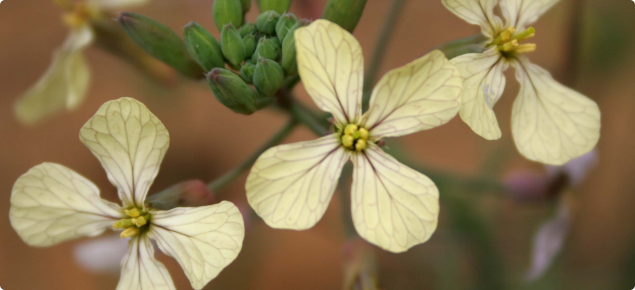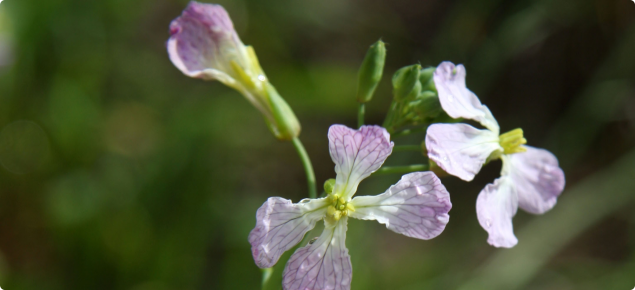Identification and attributes
Latin name - Raphanus raphanistrum
Common name - Wild radish, white weed, white charlock, wild charlock, cadlock, wild kale, wild turnip, jointed radish.
Distinguishing features
Wild radish is generally a winter and spring-growing annual that may grow up to 1.5 metres (m) high. The cotyledons are heart-shaped and hairless with long stems. The first true leaves are irregularly lobed around the edges with one or more completely separated lobes at the base of the leaf blade.
The seedling develops into a flat rosette, the leaves of which do not have a distinct stalk. Erect branches covered with prickly hairs arise from near the base as the plant matures. The rosette of lobed leaves does not persist.
Lower stem leaves are covered with prickly hairs and deeply lobed, with a rounded terminal lobe. When crushed, these leaves have a strong turnip-like odour. Upper stem leaves become narrower, shorter and often undivided.
Flowers are in clusters on the ends of stem branches. They have four petals, which alternate with four sepals. The petals may vary in colour; yellow or white petals are more common than purple, pink or brown. Petals often have light or dark distinct veins. The seed pod is constricted between the seeds and does not split lengthwise.
It breaks up into distinct segments when ripe and during threshing it is often broken up into single-seeded segments. Each pod usually has three to nine seeds, ovoid to almost globular, yellowish to reddish brown and covered with white bran-like scales. There is no seed in the beak of the pod.
Wild radish can be confused with wild turnip (Brassica tournefortii), charlock (Sinapis arvensis), turnip weed (Rapistrum rugosum) or garden radish (Raphanus sativus).
Biology
Wild radish produces abundant seeds. In Western Australia, wild radish is a more prolific seeder than wild turnip, doublegee, annual ryegrass and brome grass. It can emerge at any time of the year providing there is sufficient soil moisture although most seed germinates during autumn and winter. Wild radish can produce seed in a very short time from germinations late in spring or during summer.
Why is it a weed?
Wild radish is easily distributed as an impurity in hay, chaff and grain. Seed pods often break into segments similar in size to wheat seed, and removing the contamination can be quite difficult. Wild radish sheds pods before crop harvest, enabling it to persist in cropping systems.
Wild radish is very competitive because the seedlings establish rapidly and grow relatively fast. The fibrous stems of wild radish make harvesting difficult by choking the header comb.
Moisture levels of harvested grain can be affected. During years with late rains, when wild radish continues to grow and remains green after crop maturity, the moisture squeezed from the wild radish stems during harvest often raises the grain moisture content above acceptable storage levels. It has allelopathic activity and extracts and residues can suppress germination, emergence and seedling growth of some crops and weeds.
Wild radish is also an alternative host for a number of pests and diseases and can cause animal health problems.
Herbicide resistance
Populations (mostly in WA) have developed resistance to herbicides in the mode-of-action (MOA) Groups B, C, F and I. Group B resistance is the most common, followed by Group F.
Group B — sulfonureas (for example, chlorsulfuron)
Group B — sulfonamides (for example, metosulam)
Group B — imidazolinones (for example, imazapic)
Group C — triazines
Group C — triazinones (for example, metribuzin)
Group F — nicotinanalides (for example, diflufenican)
Group I — phenoxies (2,4-D)
Tactics for integrated weed management
| Management tactic | Most likely % control (range) | Comments on use |
|---|---|---|
| Herbicide-tolerant crops | 90 (80–99) | Herbicide-tolerant canola is essential in wild radish infested areas |
| Burning residues | 70 (20–90) | In concentrated windrows. Use a hot fire and back-burn into the wind |
| Autumn tickle | 45 (15–65) | Follow-up rain needed for better response |
| Knockdown (non-selective) herbicides for fallow and pre-sowing control | 80 (70–90) | Add carfentrazone, 2,4-D ester or a Group B herbicide for more reliable control. Late germinations will not be controlled |
| Selective post-emergent herbicides | 90 (70–99) | Apply to young and actively-growing weeds. Repeat if necessary to control late-emerging weeds or survivors |
| Spray-topping with selective herbicides | 80 (70–95) | Wild radish may regrow if there are late rains. Good for seed-set control |
| Wiper technology | 70 (50–80) | Has potential in low-growing pulses |
| Silage and hay — crops and pastures | 80 (70–95) | Cut before embryo formation in developing wild radish seed. Graze or spray regrowth |
| Renovation crops and pastures — green manuring, brown manuring, mulching and hay freezing | 95 (90–100) | Brown manuring more efficient than green manuring and more profitable. Hay freezing works well and is the most profitable manuring option in most cases |
| Grazing — actively managing weeds in pastures | 70 (50–80) | Rotationally graze and use spray-grazing |
| Weed seed collection at harvest | 75 (65–85) | Variable results |
| Sow weed-free seed | 95 (90-100) | Very important as resistance in wild radish is increasing and introduction via crop seed is increasingly likely |



